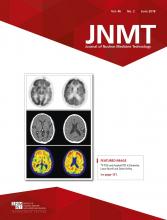Abstract
We present a case of memory loss and aphasia in a 72-y-old man and discuss how PET imaging supported a diagnosis of Alzheimer dementia despite conflicting clinical findings.
PET imaging of the brain is useful for the clinical evaluation of dementia (1). Amyloid PET imaging adds information to the current imaging standard: 18F-FDG PET metabolic imaging (2).
CASE REPORT
A 72-y-old man presented with complaints of memory loss, aphasia, and involuntary movements. Neuropsychologic testing found multiple areas of cognitive deficit and the indication of functional decline. These findings supported a diagnosis of early dementia with an unclear etiology. Some indicators suggested Alzheimer disease as the pathologic condition, whereas others suggested frontotemporal dementia. Relatively early onset of the cognitive symptoms is more suggestive of frontotemporal dementia than of Alzheimer disease.
CT imaging revealed global atrophy of the cerebrum and cerebellum, without evidence of lobar-pattern dementia (Fig. 1). The report from the second clinical visit stated that this patient had an atypical dementia syndrome with prominent language deficits. Included in the differential diagnosis were language-predominant Alzheimer disease and progressive aphasia due to frontotemporal dementia. Cognitive decline had been present for at least 6 mo. A dementia syndrome was present, and the clinical criteria were met for both Alzheimer disease and frontotemporal dementia.
Midline axial CT images of brain showing cerebral atrophy.
An 18F-FDG PET scan was ordered. The patient fasted for 6 h, and the resulting blood glucose level was 84 mg/dL. 18F-FDG (354.46 MBq [9.58 mCi]) was injected intravenously. Thirty minutes later, a 30-min PET/CT scan of the brain was obtained. The 18F-FDG PET report indicated that the observed metabolic pattern was not classic for a specific neurodegenerative process. Early frontotemporal dementia could not be totally excluded but was unlikely. The lack of a metabolic reduction in the frontal and anterior temporal cortex made the diagnosis of primary progressive aphasia, a subtype of frontotemporal dementia, unlikely. Early Alzheimer disease was a possible diagnosis because of the metabolic reductions noted in the left lateral temporal, parietal, and precuneus cortex (Fig. 2).
Midline axial 18F-FDG PET images of brain showing cortical metabolic reductions.
To further delineate the characteristics of this patient’s dementia, a β-amyloid PET scan was ordered. 18F-flutemetamol (Vizamyl; GE Healthcare) (177.23 MBq [4.79 mCi]) was injected intravenously. Ninety minutes later, a 20-min PET/CT scan of the brain was acquired. The scan was positive for cortical β-amyloid, with diffuse prominent uptake throughout the cerebral cortex and basal ganglia (Fig. 3).
Midline axial 18F-flutemetamol PET images of brain showing β-amyloid plaques.
DISCUSSION
PET imaging is useful in atypical cases when clinical evaluation, neuropsychologic testing, and anatomic imaging point to more than one potential diagnosis. PET imaging should be leveraged in the appropriate clinical scenario. In this case study, the patient clinically had symptoms of both Alzheimer disease and frontotemporal dementia. The information about metabolic changes that was added by 18F-FDG PET imaging aligned better with Alzheimer disease, and the β-amyloid PET imaging further supported this diagnosis. This high degree of clinical diagnostic certainty based on PET imaging, despite an atypical presentation, allowed clinicians to initiate proactive care planning.
CONCLUSION
Clinical symptoms of cognitive impairment can point to a variety of diagnoses. Appropriate use of advanced PET imaging can support clinical decision making and lead to the most accurate diagnosis for the patient.
DISCLOSURE
No potential conflict of interest relevant to this article was reported.
Acknowledgments
This case study was prepared as part of the Brain Tech TIME initiative of the SNMMI-TS.
Footnotes
Published online Dec. 22, 2017.
- Received for publication November 10, 2017.
- Accepted for publication November 27, 2017.










